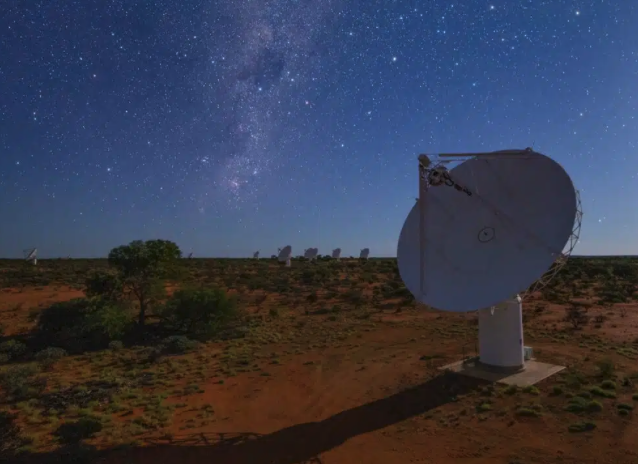Deep in the Milky Way, something strange is happening. About 15,000 light-years from Earth, a mysterious space object is pulsing regularly every 44 minutes, sending out bursts of radio waves and powerful X-rays. Scientists have never seen anything like it. It’s not acting like a normal star, and it doesn’t fit the pattern of black holes or pulsars. Now, researchers say this discovery could change what we know about how extreme objects behave in space.
The object, named ASKAP J1832−0911, was first detected in December 2023 by the Australian Square Kilometre Array Pathfinder (ASKAP), a powerful radio telescope. When it appeared, it released a bright burst of radio waves—one of the strongest ever recorded. Then in February 2024, NASA’s Chandra X-ray Observatory caught something even more surprising: X-rays coming from the same spot, flashing on the same 44.2-minute cycle. That combination of radio and X-ray emissions has never been seen before from a source like this.
What makes this object so unusual is how slowly it pulses. Most known pulsars—the spinning remains of collapsed stars—flash every few milliseconds. This one is far slower, making it part of a group called long-period radio transients (LPTs). Even among LPTs, ASKAP J1832−0911 stands out. It’s not just the timing that’s odd, but also the energy. The amount of X-rays coming from this object is incredibly high—scientists say it’s like the output of a billion billion lightbulbs.
To put that into perspective, it means something out there in deep space is generating more power in a short blast than almost anything else we’ve ever detected. And yet, by August 2024, the object went almost completely silent. It stopped sending out strong signals, which makes it harder to study and adds to the mystery.
Researchers say the radio waves from ASKAP J1832−0911 are highly structured, which usually means the source has a very strong and organized magnetic field. This could mean it’s a magnetar—a rare kind of neutron star with a magnetic field trillions of times stronger than Earth’s. Magnetars usually get their energy from their decaying magnetic fields, and over time, they tend to quiet down. But this object may be hundreds of thousands of years old, and it’s still giving off huge amounts of energy. That doesn’t fit current models, so scientists are trying to figure out how it’s doing it.
There’s also a second theory. ASKAP J1832−0911 might be part of a binary system involving a white dwarf—a very dense, Earth-sized star left over after a star dies. If it’s orbiting close to another object with a powerful magnetic field, the interaction between the two could produce bursts of radio and X-ray energy. But for that theory to work, the white dwarf would need to have a magnetic field stronger than any we’ve ever seen.
@chandraxray and @SKA_Australia telescope have uncovered a strange cosmic object: ASKAP J1832−0911. It emits powerful, synchronized bursts of X-rays and radio waves every 44 minutes—unlike anything scientists have seen before. This behavior doesn’t match known neutron stars or… pic.twitter.com/kUCpMz3A1Y
— Piotr Dyląg (@PitPlayfun) May 28, 2025
Whatever it turns out to be, scientists are calling this part of space “death valley”—a region where normal rules about star behavior start to break down. Despite this, the object is active, visible, and behaving in ways that current science can’t fully explain.
To confirm what they were seeing, astronomers used telescopes from around the world and in space, making sure that the radio and X-ray signals matched up exactly. They did. Both signals pulsed every 44.2 minutes like clockwork, showing that they came from the same source.
Astronomers Stunned by Milky Way Mystery• ASKAP J1832-0911 Pulses with Radio and X-ray Signals, Defying Stellar Theories. In the vast cosmic tapestry, astronomers have unveiled a celestial enigma dubbed ASKAP J1832-0911, a mysterious object pulsing with both radio waves and… pic.twitter.com/uBBmITBeWk
— Nirmata (@En_formare) May 28, 2025
The discovery suggests that more of these strange objects could be scattered across the galaxy. If they only turn on for a few months at a time, it’s possible we’ve missed many of them. Researchers now plan to keep watching the sky more carefully, hoping to catch other signals like this one.
For now, ASKAP J1832−0911 is offering a powerful reminder: space is still full of surprises. And sometimes, they come like clockwork, flashing every 44 minutes from thousands of light-years away.




